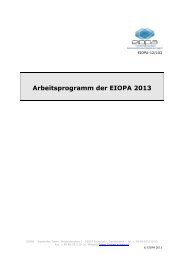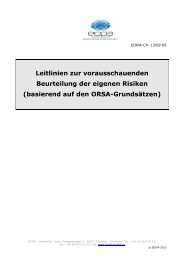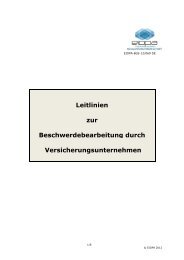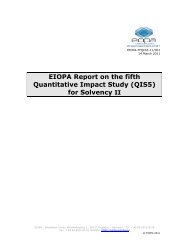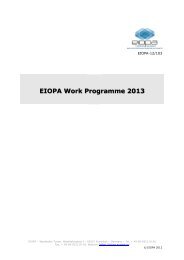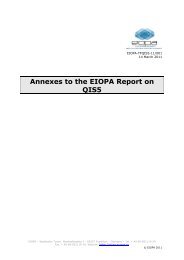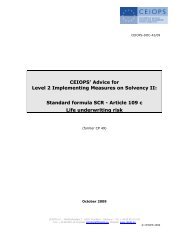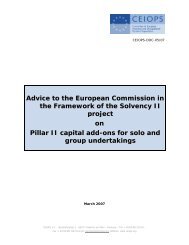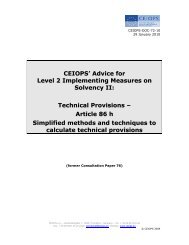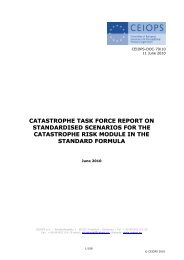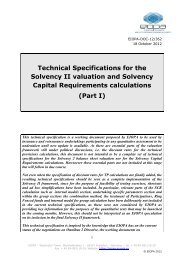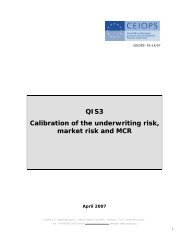CEIOPS Task Force Report on the Liquidity Premium - Eiopa
CEIOPS Task Force Report on the Liquidity Premium - Eiopa
CEIOPS Task Force Report on the Liquidity Premium - Eiopa
You also want an ePaper? Increase the reach of your titles
YUMPU automatically turns print PDFs into web optimized ePapers that Google loves.
address not <strong>on</strong>ly <strong>the</strong> change in <strong>the</strong> level of credit spreads, but also <strong>the</strong> term structure<br />
for <strong>the</strong> level of spreads. Also it would require knowledge of <strong>the</strong> ratings and durati<strong>on</strong>s<br />
of <strong>the</strong> b<strong>on</strong>ds in <strong>the</strong> model portfolio.<br />
Fur<strong>the</strong>r we note that it is assumed that <strong>the</strong>se changes are made <strong>on</strong>ly to <strong>the</strong> (sub-<br />
)charge of <strong>the</strong> spread risk module covering <strong>the</strong> exposure of b<strong>on</strong>ds. The calibrati<strong>on</strong> of<br />
<strong>the</strong> o<strong>the</strong>r sub-charges (for structured credit products, credit derivatives and mortgage<br />
loans) is more complicated and could not easily be amended to allow for a liquidity<br />
premium <strong>on</strong> <strong>the</strong> liability side.<br />
It should also be pointed out that a re-calibrati<strong>on</strong> of <strong>the</strong> spread risk factors to “full”<br />
spreads is likely to lead to a significant increase in <strong>the</strong> spread risk charge. Indeed, we<br />
note that <str<strong>on</strong>g>CEIOPS</str<strong>on</strong>g> decided to switch to a calibrati<strong>on</strong> <strong>on</strong> basis of CDS spreads in<br />
reflecti<strong>on</strong> to comments from stakeholders that a calibrati<strong>on</strong> of charges <strong>on</strong> basis of<br />
“full” spreads (as <str<strong>on</strong>g>CEIOPS</str<strong>on</strong>g> suggested in <strong>the</strong> pre-c<strong>on</strong>sultati<strong>on</strong> versi<strong>on</strong> of its advice <strong>on</strong><br />
<strong>the</strong> calibrati<strong>on</strong> of market risk) would lead to an excessive level of <strong>the</strong> spread risk<br />
charge.<br />
Adjustments to correlati<strong>on</strong> assumpti<strong>on</strong>s<br />
In its Level 2 advice <strong>on</strong> correlati<strong>on</strong>s in <strong>the</strong> standard formula, <str<strong>on</strong>g>CEIOPS</str<strong>on</strong>g> has suggested<br />
<strong>the</strong> following correlati<strong>on</strong> parameters for spread risk in relati<strong>on</strong> to <strong>the</strong> o<strong>the</strong>r sub-risks<br />
in <strong>the</strong> market risk module: 13<br />
Interest<br />
risk<br />
rate Equity risk Property risk Currency risk C<strong>on</strong>centr. risk<br />
50%/0 14 75% 50% 50% 50%<br />
These factors have been derived <strong>on</strong> basis of extensive statistical analysis which<br />
c<strong>on</strong>sidered <strong>the</strong> correlati<strong>on</strong> of a widening of credit spreads with a movement in o<strong>the</strong>r<br />
market risk drivers in historical data. In case <strong>the</strong> spread risk module is amended as<br />
described above, <strong>the</strong>se factors would need to be revised since <strong>the</strong>n spread risk would<br />
be c<strong>on</strong>sidered as a two-sided ra<strong>the</strong>r than <strong>on</strong>e-sided risk.<br />
For example, <strong>the</strong> current factor of 75% between spread risk and equity risk is based<br />
<strong>on</strong> observing a high correlati<strong>on</strong> in <strong>the</strong> tail between a widening of spreads and a fall in<br />
equity markets. However, this factor would not appropriately describe <strong>the</strong> correlati<strong>on</strong><br />
between decreasing spreads and decreasing equity values (since in practice we would<br />
envisage scenarios giving rise to decreased equity values and decreased spreads as<br />
rare and as very temporary aberrati<strong>on</strong>s). Similar problems would occur with respect<br />
to interest rate risk, where already “two-sided” correlati<strong>on</strong>s were introduced since<br />
interest rate risk is also a two-sided risk.<br />
Implicati<strong>on</strong>s <strong>on</strong> <strong>the</strong> calculati<strong>on</strong> of risk margins<br />
Risk margin is calculated using <strong>the</strong> cost of capital approach. Under this approach <strong>the</strong><br />
risk margin is <strong>the</strong> actual value of future remunerati<strong>on</strong>s, above <strong>the</strong> risk free interest<br />
rate, to shareholders due <strong>the</strong> increase of <strong>the</strong> SCR at each future point in time used in<br />
projecti<strong>on</strong>s.<br />
13 Cf. <str<strong>on</strong>g>CEIOPS</str<strong>on</strong>g>-DOC-70/10<br />
14 Depending <strong>on</strong> whe<strong>the</strong>r <strong>the</strong> insurer is exposed to a rise or a fall in interest rates<br />
22/33<br />
© <str<strong>on</strong>g>CEIOPS</str<strong>on</strong>g> 2010



